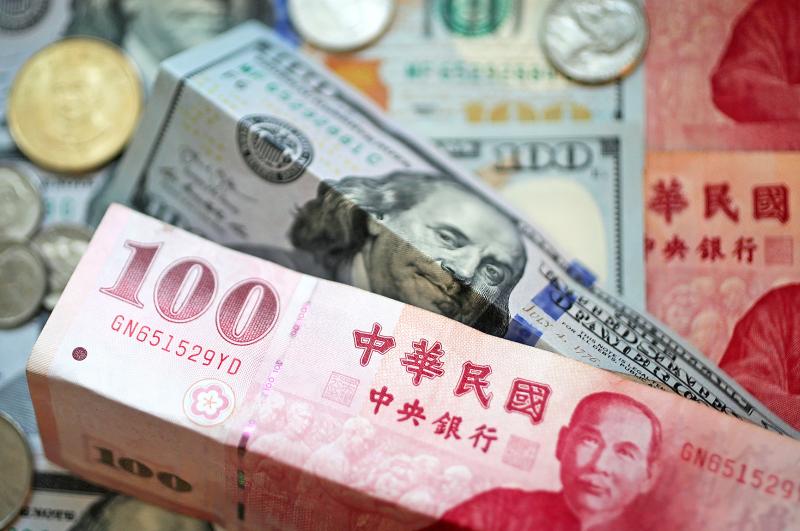Fund outflows from Taiwan reached a record high in the first quarter of this year, marking the 47th consecutive quarter of cash transferring out of the country, as the central bank attributed the pattern to overseas bond investments by Taiwanese financial institutions.
It was the third straight quarter that Taiwan reported record high fund outflows.
Data compiled by the central bank showed net outflows in Taiwan’s financial account — which measures the flow of direct investment and portfolio investment — totaled US$32.22 billion in the January-to-March quarter, up from US$18.56 billion a year earlier.

Photo: CNA
The first quarter’s fund outflow also beat the US$31.78 billion recorded in the fourth quarter of last year, the central bank’s statistics showed.
A spike in US Treasury yields prompted many Taiwanese financial institutions to park funds overseas after the US Federal Reserve introduced a rate-hike cycle that began in March, bank officials said.
The increase in net fund outflows came after portfolio investments abroad posted a net asset increase of US$49.92 billion, as insurance companies raised their investment in debt securities overseas, they said.
Out of the US$49.92 billion, residents’ portfolio investment abroad posted a net increase of US$35.21 billion on the back of a rise in overseas debt securities investment by insurance companies as well as other financial institutions, bank officials said.
Non-residents’ portfolio investment recorded a net fall of US$14.72 billion, as foreign investors reduced equity holdings in the local stock market in the first quarter, when the TAIEX shed 525.37 points, or 2.88 percent, after foreign institutional investors sold a net NT$459 billion (US$15.48 billion).
Over the past 47 quarters, accumulated net fund outflows hit US$660.51 billion, equivalent to more than seven years of Taipei’s tax revenue.
Addressing concerns that investors could continue to move funds out of the country and into US dollar-denominated assets, the central bank said that net financial account outflows are common among countries like Taiwan, which have a long-term current account surplus.
Other countries, like Japan, Singapore, South Korea and Germany, which have all had such a surplus, have also tended to record net financial account outflows, the bank said.
A current account mainly measures exports and imports of merchandise and services.
Taiwan in the first quarter recorded a current account surplus of US$30.68 billion, up US$4.85 billion from a year earlier, reporting a US$20.47 billion surplus in commodity trade, up US$1.7 billion from a year earlier, due to solid global demand for technology products amid a digital transformation.
Additionally, service trade reported a surplus of US$4.34 billion, a new quarterly high, due to increases in cargo shipping revenue amid tight supply, the central bank said.
Meanwhile, the central bank’s reserve assets rose only US$260 million, as the bank entered the foreign exchange market by selling US dollars to cap the depreciation of the New Taiwan dollar against a strong greenback.

Taiwan will prioritize the development of silicon photonics by taking advantage of its strength in the semiconductor industry to build another shield to protect the local economy, National Development Council (NDC) Minister Paul Liu (劉鏡清) said yesterday. Speaking at a meeting of the legislature’s Economics Committee, Liu said Taiwan already has the artificial intelligence (AI) industry as a shield, after the semiconductor industry, to safeguard the country, and is looking at new unique fields to build more economic shields. While Taiwan will further strengthen its existing shields, over the longer term, the country is determined to focus on such potential segments as

UNCERTAINTY: Innolux activated a stringent supply chain management mechanism, as it did during the COVID-19 pandemic, to ensure optimal inventory levels for customers Flat-panel display makers AUO Corp (友達) and Innolux Corp (群創) yesterday said that about 12 to 20 percent of their display business is at risk of potential US tariffs and that they would relocate production or shipment destinations to mitigate the levies’ effects. US tariffs would have a direct impact of US$200 million on AUO’s revenue, company chairman Paul Peng (彭雙浪) told reporters on the sidelines of the Touch Taiwan trade show in Taipei yesterday. That would make up about 12 percent of the company’s overall revenue. To cope with the tariff uncertainty, AUO plans to allocate its production to manufacturing facilities in

COLLABORATION: Given Taiwan’s key position in global supply chains, the US firm is discussing strategies with local partners and clients to deal with global uncertainties Advanced Micro Devices Inc (AMD) yesterday said it is meeting with local ecosystem partners, including Taiwan Semiconductor Manufacturing Co (TSMC, 台積電), to discuss strategies, including long-term manufacturing, to navigate uncertainties such as US tariffs, as Taiwan occupies an important position in global supply chains. AMD chief executive officer Lisa Su (蘇姿丰) told reporters that Taiwan is an important part of the chip designer’s ecosystem and she is discussing with partners and customers in Taiwan to forge strong collaborations on different areas during this critical period. AMD has just become the first artificial-intelligence (AI) server chip customer of TSMC to utilize its advanced

While China’s leaders use their economic and political might to fight US President Donald Trump’s trade war “to the end,” its army of social media soldiers are embarking on a more humorous campaign online. Trump’s tariff blitz has seen Washington and Beijing impose eye-watering duties on imports from the other, fanning a standoff between the economic superpowers that has sparked global recession fears and sent markets into a tailspin. Trump says his policy is a response to years of being “ripped off” by other countries and aims to bring manufacturing to the US, forcing companies to employ US workers. However, China’s online warriors